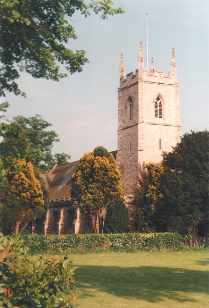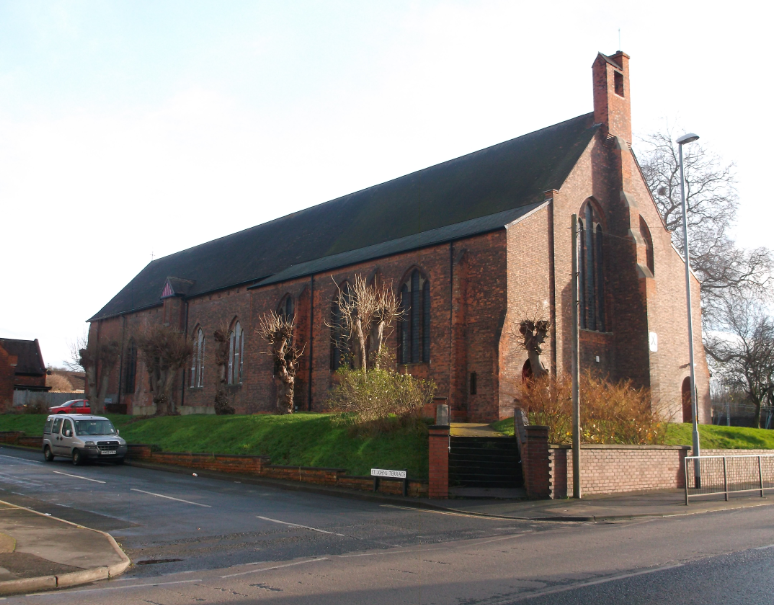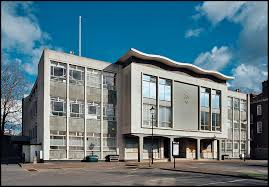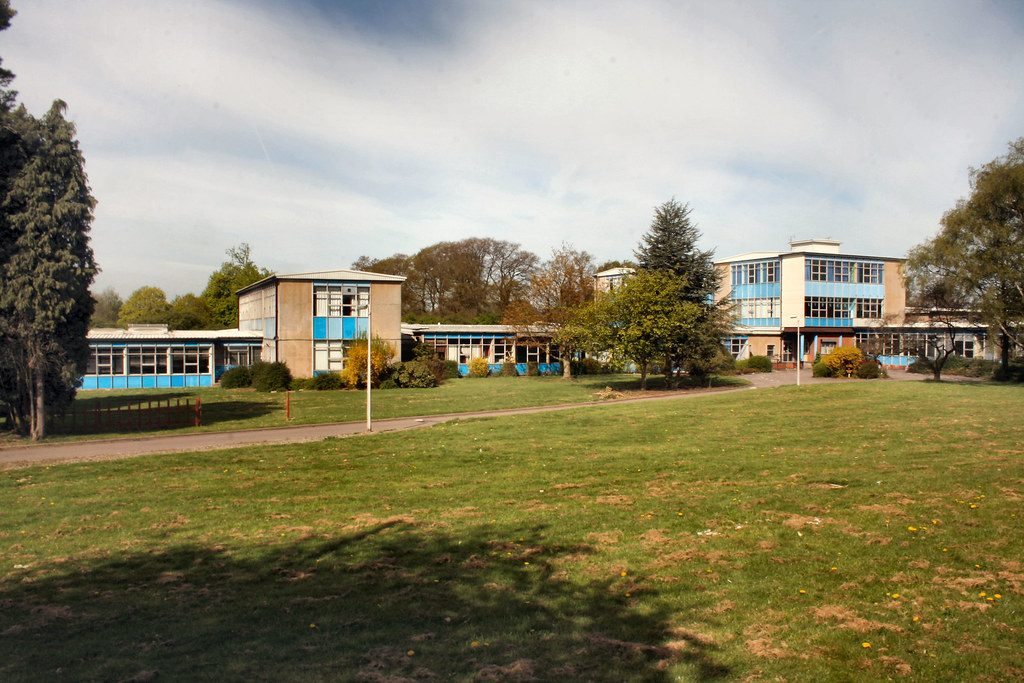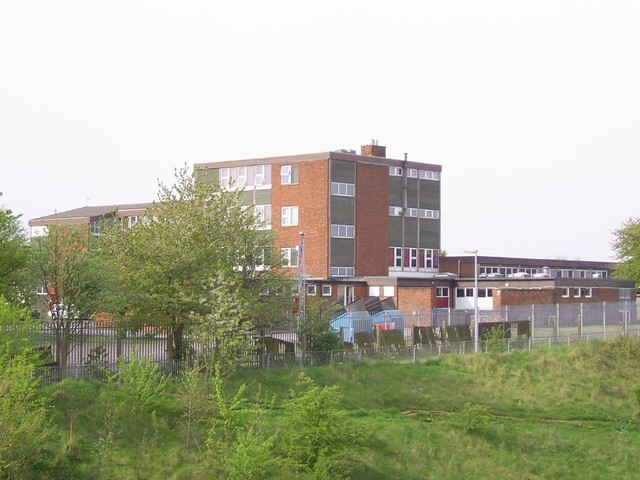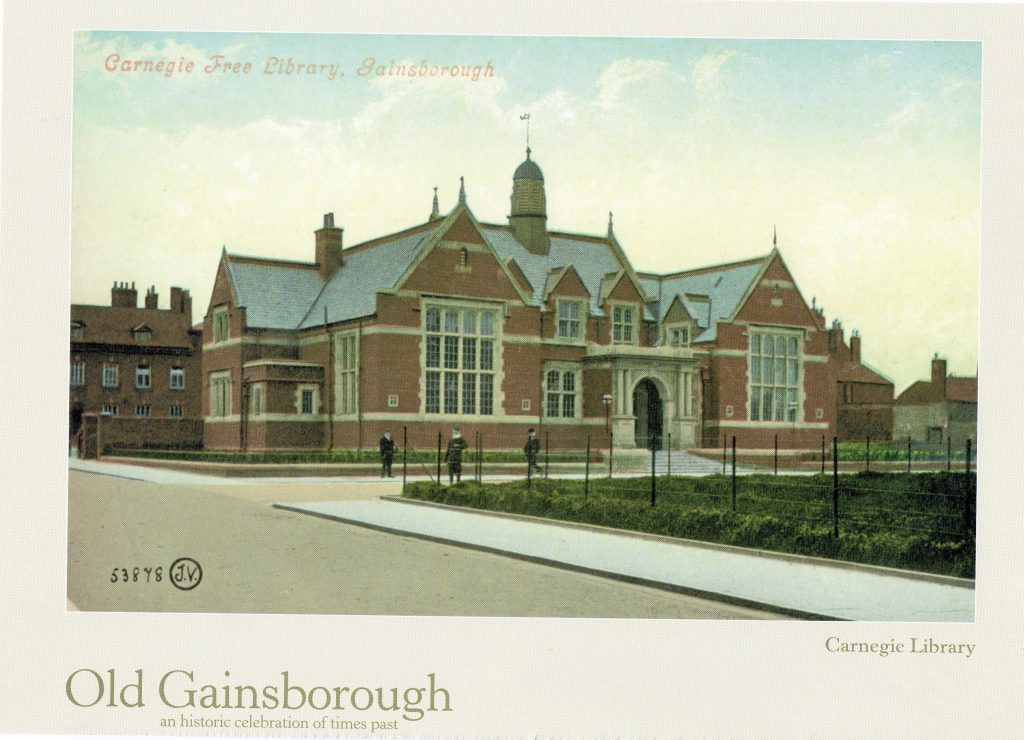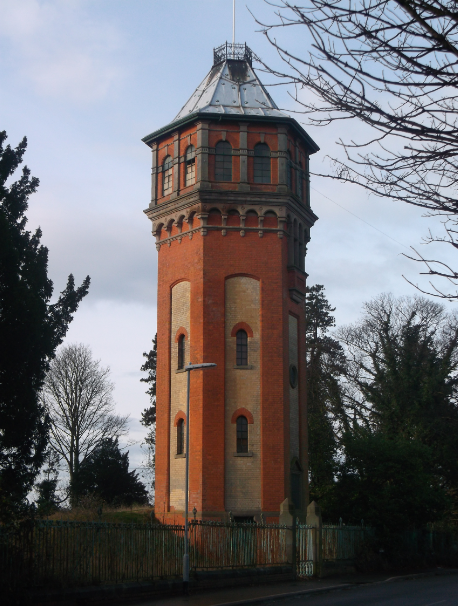Please see below the answers to last weeks Gainsborough History Quiz.
HISTORY
1. Gainsborough was the Capital of England in 1013. Which King was in charge at that time?
Answer: Dane Sweyn Forkbeard
Gainsborough was named as capital of the country, and also Denmark, for five weeks in 1013. The Dane Sweyn Forkbeard, together with his son and heir Cnut (Canute), arrived in Gainsborough with an army of conquest. Sweyn defeated the Anglo-Saxon opposition and King Ethelred fled the country. Sweyn was declared King of England, and he returned to Gainsborough. Sweyn and Cnut took up high office at the Gainsborough Castle (on the site of the present-day Old Hall), while his army occupied the camp at Thonock (today known as Castle Hills). But King Sweyn died (or perhaps was killed) five weeks later in Gainsborough. His son Cnut established a base elsewhere.
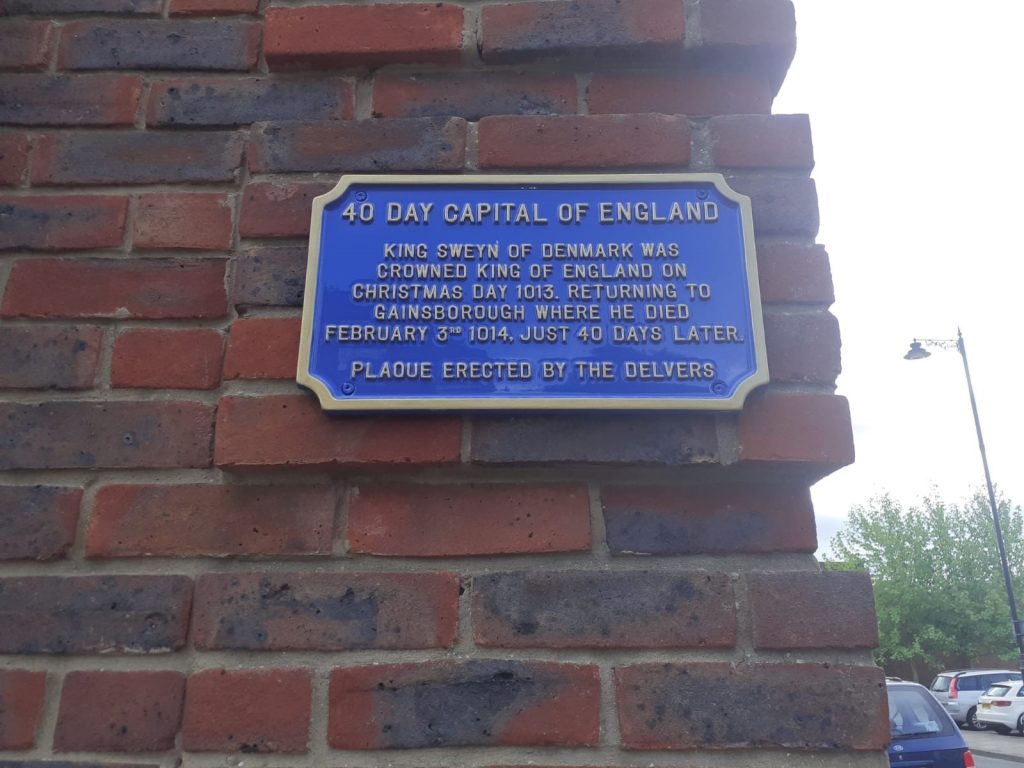
Delvers Blue Plaque commemorating King Sweyn
2. The United Reform Church stands as a memorial to the pastor of the Mayflower Pilgrims but do you know the pastor’s name?
Answer: John Robinson
The story of the Mayflower was of an English ship that transported the first English Puritans, known today as the Pilgrims, they sailed from Plymouth, England to the New World in 1620. Gainsborough has a special connection to the Mayflower anniversary as separatist movements originated in this region that led the Pilgrims on their journey to America.
John Robinson lived with his wife in Sturton-le-Steeple and became involved with leading preachers in the Nottinghamshire and Lincolnshire area, including John Smyth in Gainsborough, William Brewster in Scrooby, Richard Clifton from Babworth and Richard Bernard in Worksop. Robinson supported Clifton and his followers who had begun to meet together in Scrooby, becoming his assistant after moving from Norwich back to his birthplace. This group, the Scrooby Separatists, made an abortive attempt to emigrate to Holland in 1607 from Boston but were betrayed and Robinson was among those who were held. A second successful attempt was made from Killingholme near Immingham on the Humber in 1608.
In 1892, on the initiative of the Revd. Hugh S. Griffiths, leading Congregationalists in England and America agreed to raise a suitable church as a memorial to John Robinson. This was built on the site of the Old Vicarage (which was the birthplace of actor Dame Sybil Thorndyke). The foundation stone was laid by the Honourable F. T. Bayard, American Ambassador to the Court of St. James, on 29 June 1896.
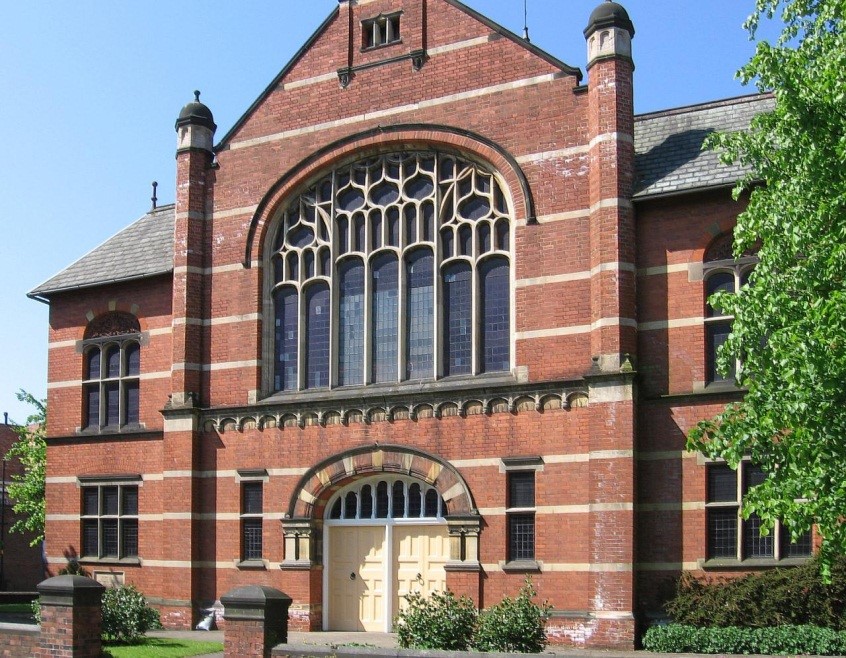
John Robinson Memorial Church Gainsborough
In 1901 a tablet was unveiled at the church which reads: “This tablet, unveiled June 11th 1902 in the 300th year after the formation of the church in Gainsborough with which the name of John Robinson is associated, stands as a record of the co-operation of American with English Congregationalists in erecting a building to commemorate him, the thought of whom stirs equal reverence in English and American hearts.”
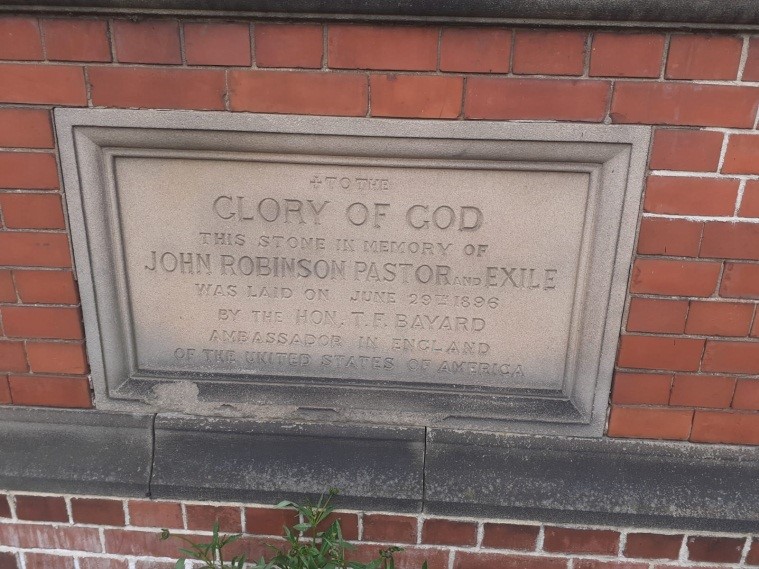
John Robinson Memorial Church Plaque
3. Until recent years where did the Mayflower II ship reside?
Answer: Long Wharf near the site of Plymouth Rock
Since 1957, Mayflower II has been a pier side tourist attraction, moored at Long Wharf near the site of Plymouth Rock. The ship has been a popular attraction near Boston; it has become the site of national and state celebrations.
The Heritage Centre has been showcasing the fascinating untold story of the Mayflower II and interactive videos can be found on the Gainsborough Heritage Association’s Facebook page or the Centre’s new YouTube channel. The story details how Warwick Charlton built a replica Mayflower ship in 1957 to retrace the historic voyage of our ancestors back in 1620.
Here is the first video in the series:
In December 2012, Mayflower II was towed to dry dock in Fairhaven Ship Yard in Fairhaven, Massachusetts, where shipbuilders and U.S. Coast Guard inspectors called for extensive repairs. This was the first in a number of scheduled repairs over the next seven years to restore Mayflower II to pristine condition for the 400th anniversary of the English settlement of Plymouth in 2020.
4. In 1947 a Great Flood occurred in Gainsborough, how has the riverside altered since that time to help defend the town of Gainsborough from further floods and tidal surges?
Answer: Building of a flood defence wall
Following flooding in 1947 a flood relief scheme was implemented in Gainsborough. The scheme consisted of a flood defence wall on the right bank of the River Trent for a distance of 2.4km at Gainsborough. These defences were continually repaired and raised until, in 1990, a study was undertaken which concluded that the defences needed replacing. In response, a new flood defence scheme consisting of sheet piling and a 5m wide piled walkway extending into the river was constructed in phases between 1996 and 1999. Click here for more information on Gainsborough’s Flood Defences.
5. Paul Kemp and Andy Birkitt are the founders of the Gainsborough Heritage Association and back in 1993 they held their first exhibition, but where in Gainsborough was this exhibition held?
Answer: Richmond House
Richmond House was there the first exhibition was held. The house itself is a large early 19th century house of two storeys in pale brick, with a hipped roof. The house was formerly listed as the Hollies and a plaque to the left of the front door of Richmond House reads ‘The Urban District Council of Gainsborough, Richmond Park. The house and grounds were given to the council by Charles Frank Richmond, Solicitor of the town, upon trust that the property be retained and used by the council as a park, pleasure ground, Museum, art gallery or similar purpose for the benefit of the community of Gainsborough and District.”
If you would like to find out more information about the Heritage Association’s story then follow the link to the blog post about the Association’s twentieth-fifth anniversary.
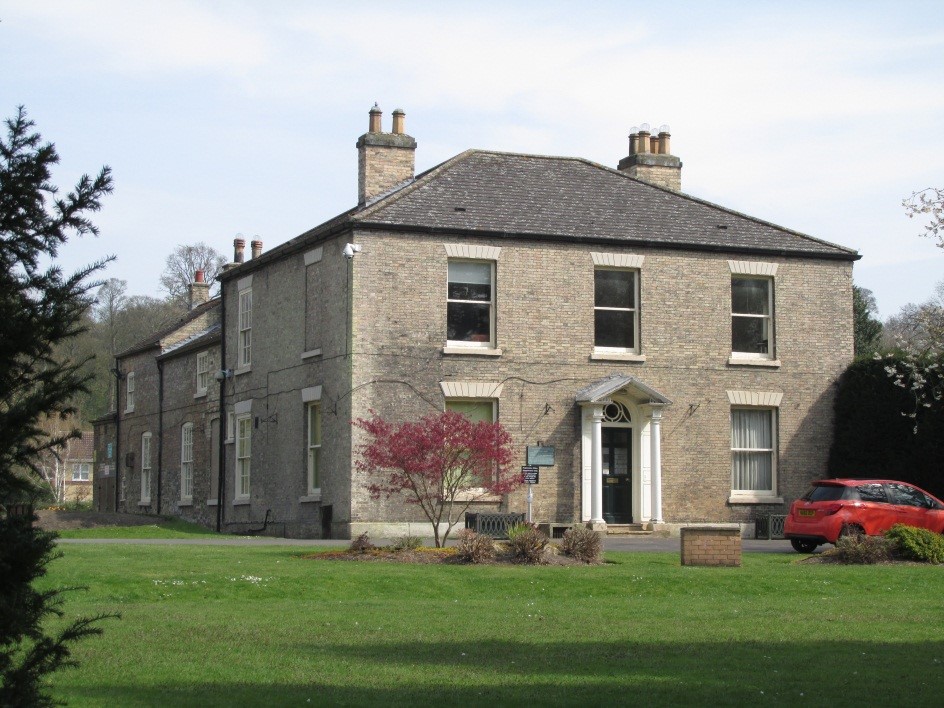
Richmond House Gainsborough
ENTERTAINMENT AND ARTISTS
6. What profession did John play in this British Television Series?
Answer: John played Thomas Watkins, the chauffeur.
John Alderton a famous actor was born in Gainsborough and starred in Upstairs Downstairs. The program was set in a large townhouse in Belgravia in central London, the series depicts the servants—”downstairs”—and their masters, the family—”upstairs”—between the years 1903 and 1930, and shows the slow decline of the British aristocracy.
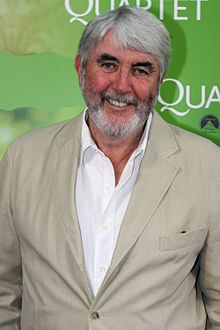
John Alderton in Sydney, November 2012
7. Julia Deakin starred alongside Jim Broadbent in which 2007 film?
Answer: Hot Fuzz
Hot Fuzz is a 2007 action comedy film directed by Edgar Wright who co-wrote the script with Simon Pegg. Pegg and Nick Frost play police officers investigating a series of mysterious deaths in a West Country village.
Julia Deakin became one of the Heritage Association’s Vice Presidents and re-opened the Gainsborough Heritage Centre after a project to create new permanent displays in 2016. She was born in 1952 in Gainsborough and is a British actress.

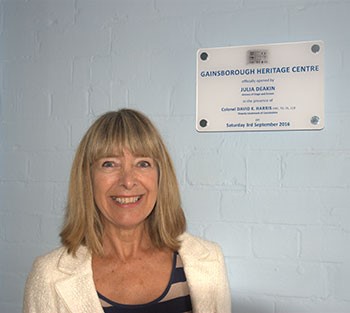
Julia Deakin
Bill Podmore was also born in Gainsborough and was a British Television Producer well known for his work on Coronation Street.
8. Bill worked on producing Coronation Street for 12 years but what was the first program that he worked on?
Answer: Sooty
For more information on Bill Podmore click here…
9. What is the famous British actress called who has a road named after her in the town?
Answer: Dame Agnes Sybil Thorndike CH DBE (24 October 1882 – 9 June 1976)
British stage actor Sybil Thorndike (1882-1976) was one of the leading figures in British theatre during the first half of the 20th century. She made her stage debut in a regional company production of “The Merry Wives of Windsor” in 1904, and achieved her greatest success in the title role of “Saint Joan”, a play written for her by George Bernard Shaw in 1924. For more detailed information on Thorndike’s career read my blog on Gainsborough Women.
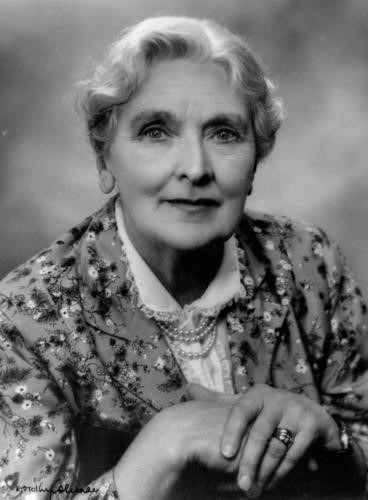
Dame Agnes Sybil Thorndike
10. What is the name of a local Gainsborough Artist who established an art studio on Curtis Walk?
Answer: Karl Wood
Karl Wood (1888-1958) was born in King’s Newton, Melbourne, Derbyshire. He later settled in Gainsborough, Lincolnshire where he was art master at Gainsborough grammar school. He had his own art studio and undertook private tuition in several subjects including painting, piano and singing lessons. Painting tuition resulted in sketching bicycle tours into Lincolnshire with his pupils. His first windmill painting was in 1926 and by 1956 he had completed 1394 windmill paintings. It was Karl Wood’s intention to publish a book on British windmills to be called The Twilight of the mills, based on his extensive travels by bicycle, but this was never completed. Karl Wood’s paintings are now housed in the Usher Art Gallery, Lincoln. For more information on Karl’s work click here…
POLITICS
11. A collection of streets to the west of Ropery Road is named Campbell, Haldane, George, Asquith, Grey, Birrell and Burns. What do you think all of there names have in common?
Answer: Liberal Politicians
Henry CAMPBELL – Bannerman (Liberal Prime Minister from February 1899 to December 1905).
Richard HALDANE (Liberal Secretary of State for War from December 1905 to June 1912).
Herbert ASQUITH (Liberal Prime Minister from April 1908 to December 1916).
David Lloyd GEORGE (Liberal Prime Minister from December 1916 to October 1922).
Edward GREY (Liberal Foreign Secretary from December 1905 to December 1916).
Augustine BIRRELL (Liberal Education Secretary from December 1905 to January 1907).
John BURNS (Liberal Government Minister from December 1905 to February 1914).
There is also a Wilson Street and that one could have been named after Woodrow WILSON (Liberal US President from March 1913 to March 1921, called the Godfather of Liberalism).
12. Who was the MP for Gainsborough prior to our current sitting MP Sir Edward Leigh?
Answer: Marcus Richard Kimball, Baron Kimball (18 October 1928 – 26 March 2014).
Marcus Kimball was a British Conservative politician. He was the Member of Parliament (MP) for Gainsborough from a 1956 by-election until 1983.
13. Who was the first Mayor of Gainsborough?
Answer: Roy Ingham
Born and bred in the town, Roy Ingham was the inaugural mayor of Gainsborough in 1992 to 1993 as well as teaching at North County Primary School and Middlefield Lane School for more than 23 years. A joiner by trade, he also had a spell in the Royal Air Force.
WAR
14. What famous battle took place in Gainsborough in the year 1643?
Answer: The Battle of Gainsborough
The Battle of Gainsborough was a battle in the First English Civil War, fought on 28 July 1643. The strategically important town of Gainsborough was a Royalist base, used for harassing the Parliamentarians who were generally dominant in Lincolnshire. A short-lived attempt to capture it for Parliament was defeated by Charles Cavendish in a battle that saw Colonel Oliver Cromwell distinguish himself as a cavalry leader.
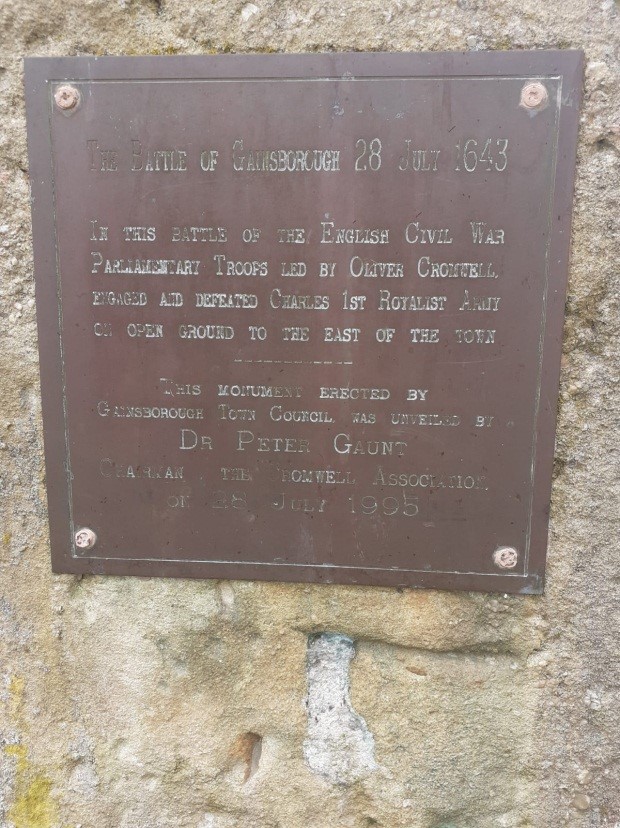
Gainsborough Civil War Memorial Foxby Hill
15. During WW1 what aeroplane was produced in Gainsborough by Marshall Sons and Co at Marshall’s Carr House Works on Lea Road?
Answer: Bristol Fighter Aeroplane
The Bristol Fighter was the aeroplane built by Marshall Sons and Co as subcontractors producing 150 machines. Over 3,800 Bristol Fighters were built during the 1914-1918 war, and production continued into 1919. The Carr House Works was where the Gainsborough firm built their Bristol F-2B Planes were constructed. The Marshall family owned a large house on Lea Road called Carr House. The house can be seen in the photo above just across the road from the Workhouse (where the Petrol Station and Evans Halshaw is today). The factory was built in the grounds of the house. The house became completely surrounded by the factory and was eventually demolished. You can see Lea Road Station just at the bottom of the photo. In November 1917 Marshalls obtained a contract to built 150 Bristol fighters and four large workshops were erected in the grounds of Carr House. These building used “Belfast trusses” which resulted in the distinctive shallow curved roof.
Frank Barnwell designed the Bristol F2 for the British and Colonial Aeroplane Company during the spring of 1916. The original idea was to produce a two-seater reconnaissance plane that could take over from the obsolete BE-2. However, while working on the new aircraft, Barnwell decided to make a fighter plane. The aircraft reached the Western Front in March 1917. The first few weeks were a disaster when four of the first six aircraft were immediately shot down by Manfred Von Richthofen and his colleagues. Once pilots learned to use the new machine properly, its strength, speed and agility enabled it to compete with German fighter aircraft. By 1918 the Bristol F-2 was the most successful fighter plane on the Western Front. Later versions of the plane remained in RAF Service until 1932.
Marshall Sons & Co were not just responsible for producing the Bristol Fighter but also produced for the war effort shells and fuses of various kinds, bombs, gun mountings, gun pedestals, trench pumps, water-carts, G.S. wagons, G.S. limber wagons, officers’ mess carts, trailer wagons, cast-iron bombs, aerial, infantry Supply Tanks Mark IX, cordite presses, reeling machines, acid tanks and containers, shell bogie trucks for filling factories, buffer cylinders for naval guns, ammonia stills, ammunition boxes, midget submarines and of course the Bristol Fighter aeroplanes.
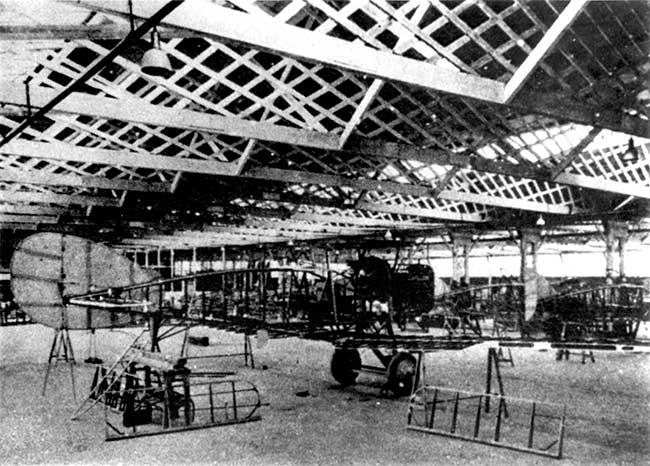
Bristol Fighter assembly Carr House Works WWI
16. Where was the National Shell Filling Factory No. 22 located in Gainsborough in WW1?
Answer: Thonock
The National Shell Filling factory No.22 was built by the Office of Works on the outskirts of Gainsborough at Thonock and was connected by sidings to the railway. Building began on 24 November 1917 but was hampered by “bleak and bitter weather.” Workers were brought in from across the country and were lodged in Morton Wesleyan School, Morton House, the Labour Exchange (where Horsley’s is today), and Stokes & the Harrison Saleroom on Church Street. In January 1918 the “News” reported that “1,000 fresh workmen have been drafted into the town and immediate neighbourhood” but there were problems feeding them all. The report says that some of the workers were Hull Dockers.
Progress was rapid. The first “Sinker” was filled on 14.2.18 and the first four were sent to Portsmouth four days later. The next sinkers did not arrive to be filled until March 7. Sinkers were a ground mine with a charge of 1,000 of crude T.N.T. contained in a concrete shell detonated on the approach of any magnetic body.
Problems with the labour supply up to March 1918 hampered production but this was resolved and a night shift was started on March 13.
The site had 3,000 yards of railway sidings connected to the main Great Central Sheffield – Gainsborough – Grimsby line and there were narrow gauge tracks linking the filling buildings. A platform was built and a train provided so that workers could be transported from the town. “Sinkers” were filled with 1,000 pounds of T.N.T. and they aimed to be able to produce 700 per week. There were two Units. Unit 1 was completed first and by June 1918 maximum production was reached with an output of 70 Sinkers per day, with two shifts. On June 29 they were told to limit production to 250 per week, later further reduced to 160 a week and by September up to 180 a week. When Unit 2 was completed in July it was allocated to fill 250 H2 Naval mines with ammonium perchlorate.
Between January and September 1918, Herbert Bing O.B.E., was in charge as Managing Director. He had been M.D. of Banbury National Filling Station and had been awarded and O.B.E. “for services in connection with the war.” After Bing left the next M.D. was Mr. C.R. Freeborn.
Bing reported that the filling buildings of Gainsborough were well ventilated and they did not need to use mechanical ventilation. He said there were no serious cases of TNT poisoning although a few women had to be taken off this work as they had preliminary symptoms.
TNT poisoning had been a serious problem in the early years of the war, TNT can cause toxic jaundice which turns the skin of workers bright yellow and can be fatal. This earned them the nickname “canaries”. From September 1918, 50,000 Howitzer bombs were sent to the factory for storage and any surplus labour was employed emptying them. By the end of October 1918, the factory had 322 employees, 53.4% were women. From 13 November all filling work ceased and arrangements were made to work on emptying 700 bombs per day. The night shift was abolished and working hours were reduced. 15% of the workers were demobilised. In December 1918 the “News” reported that Mr Bing had returned to Gainsborough for a presentation to be made to him and during his speech:-
“Mr Bing especially praised the T.N.T girls for their most admirable work. The work they had done had proved very valuable to their country. It was very brave of the girls to work among the high explosives.”
After the Armistice the factory carried on for several more years decommissioning ordnance. In October 1920 the factory was taken over by a London based scrap metal company, George Cohen, Sons and Coy.
17. What year was Gainsborough’s Cenotaph unveiled?
Answer: 1921
The unveiling of the Cenotaph took place on Sunday, October 9, 1921. The ceremony was carried out by Brigadier-General Sir J. F. Laycock from Wiseton Hall. He was the commanding officer of the Nottinghamshire Royal Horse Artillery.
A very detailed report from the Gainsborough News on the unveiling ceremony explains it was just over a year since Stephen Gray J.P. and Major Bell first mooted the project of a Cenotaph. Herbert Alfred Bell was a solicitor who lived at Cedar Cottage, North Marsh Road, he was involved in the Territorials before the war. Stephen Gray was a local J.P. and ran a grocery business – he lived on Summer Hill and had sons in the army.
A planning committee was formed – including Major Marshall, Mr. Gray, Major Bell and others. Mr Thomas Tatam was the architect. He had served in WW1. He was the son of a Harpswell farmer and had trained as an architect before the war.
Herbert Dorrington was the monumental mason who built the Cenotaph, (Dorrington’s was at the end of Spital Terrace just across the road from the present-day Heritage Centre). His son had been badly wounded in the head by a bullet in 1917. Sir Hickman Bacon gave the land and also paid for the lettering to be lead filled.
The News report states that Mr Gray told the crowd that, “They should keep green the memory of the men who had sacrificed their lives in the war. It was the least that they could do.” The Buglers of the Territorials sounded the Last Post and the wreaths were laid.
The first wreath was laid on behalf of the committee which planned the Cenotaph. Then non-commissioned officers of the Lincolnshire Regiment laid wreaths followed by ex-service men’s wreaths. Members of the ex-Service Men’s Club laid two wreaths.
The newspapers say the buglers then sounded the Reveille and the National Anthem was sung. Then there was a march past at the salute. The ringers of the Parish Church sounded a muffled peal at the conclusion. Before the unveiling ceremony there had been a procession from the Market Place consisting of the Britannia Band, Salvation Army Band, Territorial Band, Territorial Drums and Bugle Corps, the British Legion and other ex-Servicemen, the Local Volunteer Company, the St John Ambulance Corps under Superintendent Linley. Scouts with the drums and buglers, Girl Guides, Fire Brigade, Magistrates, Urban District Council. The Local Territorial Company provided the guard of honour. Local clergy led the procession from the Market Place along Lord Street to the Cenotaph. The British Legion provided stewards. Near to the Cenotaph, there was a platform on which sat Sir Hickman Bacon, special guests and the clergy.
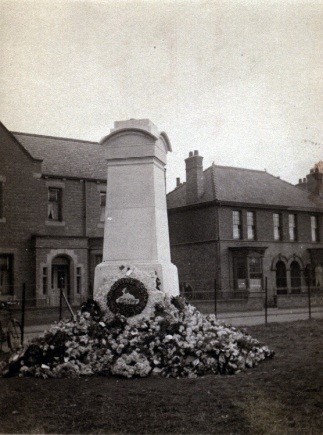
The Gainsborough Cenotaph
18. What was the first aircraft to arrive at RAF Blyton in WW2?
Answer: Vickers Wellington
The first plans for an airfield were drawn up for Blyton in early 1941. The site chosen was only 1.5 miles from the village of Blyton. As with most airfields built during this time period, Blyton was built to the standard Class ‘A’ pattern. This consisted of three runways crossing each other surrounded by a peri-track. Thirty-six hard pan standings were built to cater for the impending heavy bombers due to arrive.
Once opened the station was immediately placed under the control of RAF Lindholme and 1 Group, Bomber Command, as a satellite station, but control was later moved to Hemswell on 6 July 1942. The residents to the airfield were No.18 OTU ‘B’ Flight, Polish Air Force on the 10 July. In turn, the first aircraft arrived at the airfield in the form of the Vickers Wellington, which No.18 OTU was currently using at their home base at Hemswell. For more information on the history of RAF Blyton click here…
19. What year did the Market Street Raid happen in WW2?
Answer: 1942
Gainsborough received its first direct attack in the early hours of the morning on the 29 April 1942. A Dornier 217 bomber approaching from the North West dropped a stick of 500kg G.P bombs on the Town Centre. Damage to property was severe. Buildings fronting Market Street, Church Street and Roseway were demolished and Heaton Street ceased to exist. The raid caused problems for the Ministry of Food when a large cold store, containing most of the town’s meat rations was completely wrecked. By the end of this raid, the destruction caused is shown: 39 shops and businesses damaged; one public house; one hotel; the billiard hall, cold store and a row of dwellings. There was widespread blast damage to a large area of the town, including the telephone exchange and the front wall of the Town Hall which had to be re-built.
Seven people were killed and six seriously injured. Four soldiers of the Leicestershire Yeomanry died when their Sergeant’s mess received a direct hit. Civil Defence Rescue Services found their efforts hampered by coal, gas and water from fractured pipes, but managed to rescue survivors before daylight. Mr and Mrs A Coulson, the licensees of the Marquis of Granby died when their hotel was demolished. Mr Ralphs, a tailor by profession, was also killed. The rescue services were unable to free his body until the next day. An innkeeper and his wife of the Peacock Inn managed to crawl out of their bed and were rescued after clinging to a tilting bedroom floor when the front of the building had been blown off. There was a fire in a tobacco warehouse which was brought under control by the fire service. The residents of a row of cottages were fortunate to escape serious injury when their homes were completely wrecked. However, there was no interruption to the production in the factories. Marshall’s engineer’s extension did suffer from the blast damage to the windows and roof, but luckily there were no causalities.
In the civil defence headquarters, no air raid warnings had been received and no condition red was in operation in the county of Lincolnshire. The only explanation found for this raid on Gainsborough was another raid that was taking place in the city of York. This raid was the only action in the north of England that night, so ultimately it went wrong and the plane was looking for an alternative target. The aftermath of this raid still caused problems for Gainsborough as the question was, was there an unexploded bomb included in the stick? A thorough search was carried out over the whole area but nothing was found. Following the raid, the local council held a meeting at which tributes were paid to the Civil Defence Services and military personnel for their efforts after the raid was over.
Visit my recent blog post on War Memories to hear some oral history accounts of this raid in Gainsborough.
INDUSTRY
20. William Rose is famous for producing packaging machinery at the Roses factory in Gainsborough. What mode of transport did the company also produce?
Answer: Car
William Rose’s interests did not end at packaging machines. In 1898, while in his thirties, he decided to manufacture his own cars rather than buy them. His first car was so successful that personal friends became potential customers. Commercial production was started, but as a 1905 National catalogue pointed out:
“Progress was, however, slow as with the experience gained in manufacturing succeeding cars many alterations and experiments were found compulsory in order to deliver what the makers aimed to supply, viz., the perfect automobile; but it is pleasing to know that every car was an advance on the last”.
Most components, including the nuts and bolts, was made in his Gainsborough factory and by 1908, 37 Rose National cars had been sold. A three-cylinder engine became the standard power unit, although a four-cylinder model was introduced later. The 18-22 hp engine operated at 900 rpm and gave a top road speed of 40 miles per hour at 1,200 rpm. Petrol consumption was said to be 26 miles per gallon. Six different models were made, and the early wickerwork bodies were replaced by coachwork with real leather upholstery.
A Rose car won a hill-climbing competition run by the Lincolnshire Automobile Club in September 1905 and this ability was mentioned in the 1905 catalogue as – “The change-gears enable us to climb any hill on a turnpike road in the world with the full load and without exertion”.
It is understood that this car had caught fire the previous day in the fitting shop. A motoring paper reporting the accident stated – “It was probably caused by one of the workmen having a lighted candle underneath the car”.
Rose cars were exported widely. One model was known to have been used on a touring holiday in France. Unfortunately, it overheated in the hot continental sun and was abandoned until it could be towed by horse to Rouen and eventually shipped back to Hull. Rather human in their temperamental ways, these old cars provided an adventure and frustration to their owners that is somehow missing in present-day motoring.
The National was made in both the Landaulette and open styles. The price of a six-seater Landaulette, complete with electric lights, was £625, a not inconsiderable sum in those days. One of his creations, a 40hp model, raced at Brooklands, before being converted into a fire-engine, in which guise it remained in service at the Rose works until WW2. The engine – now in Lincoln Museum – had many interesting features not least the aluminium cylinder block of unusual toughness supporting individually cast cylinders. A dual ignition system – trembler coil for starting and magneto for running – was employed with two sparking plugs in each cylinder. An up-draught carburettor of Rose design fed the petrol mixture, the jet position being adjustable from the steering wheel. The clutch was a leather-faced cone, and although it gave good, easy gear changes, its tendency to slip under load was apparently cured by a handful of sand.
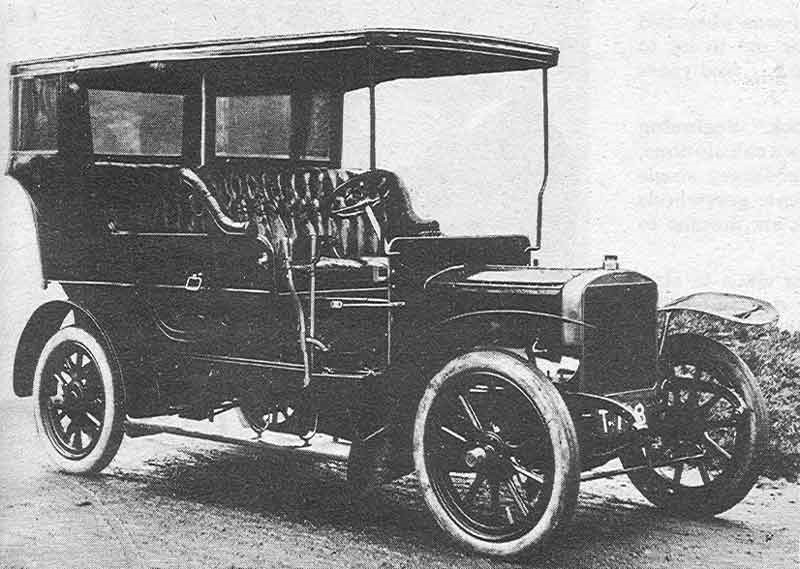
1905 Rose National Motor Car
A number of the constituent companies of the Baker Perkins Group were caught up in the motor manufacturing hysteria that permeated the engineering industry at the beginning of the 20th century. A.M. Perkins &Sons had toyed with the application of steam power to road traction in the previous century but Rose Brothers (Gainsborough) Ltd, Job Day & Sons Ltd and Werner, Pfleiderer & Perkins Ltd had all seriously attempted to produce viable motor vehicles but had met with varying levels of success. Even Joseph Baker & Sons Ltd had taken an agency for an American built car. It is understood that perhaps the nearest that the Group came to becoming a car giant was – according to the 1945 diary of the father of Rose Brothers’ sales manager, W.L. Fitchett – when, “Sir Herbert Austin came to the Gainsborough works with a view to taking them over. If this had taken place, Gainsborough would have become the home of the Austin car”. For more information on the Roses firm click here…
21. What year was Eminox founded?
Answer: 1978
The company was started in 1978 and is based in Gainsborough. The name ‘Eminox‘ is derived from the initials of two founders, Norman Emerson and David Milles, and ‘Inox’ refers to “stainless steel”.
If you take a look at the picture below it shows a house that sits right at the top of Colville Terrace which is near where the Tesco supermarket now stands in the town.
22. If you look closely you can see that the house has been cut off at an odd angle, can you work out why this might be?
Answer: Boiler produced at Marshall’s factory couldn’t fit down the street…
The boiler shop of Marshall’s Sons and Co once stood where Tesco’s now stands today. Colville Terrace now a side street was once the main road that ran alongside the outside of the factory.
If you watch the video below on the history of Marshall’s Paul Dawson recalls the story of why the house at the top of Colville Terrace was cut off.
23. What year did Marshall’s start producing the Field Marshall tractor?
Answer: 1945
The video above details some information on the history of products produced by the Marshall firm. However, the model ‘M’ agricultural tractor was introduced in 1938. The tractors were suitable for driving threshing machines and able to cope with a 4-furrow plough on heavy land. The renowned Series 1 Field Marshall tractor was produced in 1945. In 1941 the Ministry of Agriculture announced that it wished to place an order for 2,000 agricultural tractors to assist its programme of boosting home-grown food production. The new 2-stroke single cylinder horizontal diesel engine was a great improvement on earlier designs and tests confirmed that the fuel consumption was less than 1 gallon per acre.
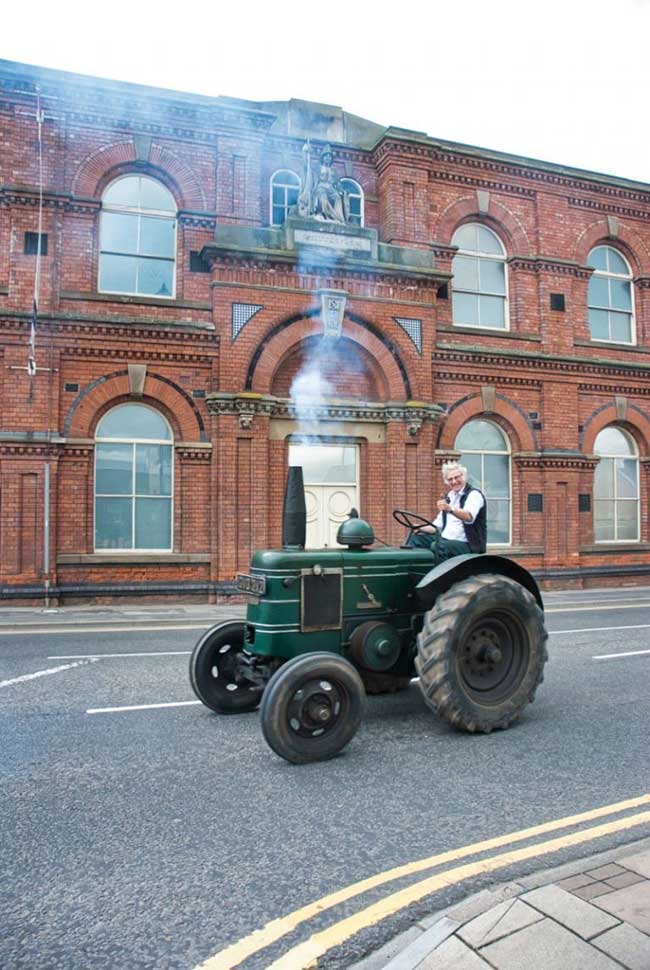
Paul Ducksbury on a Field Marshall Series 1 outside the former Britannia factory of Marshall’s in 2018 on Father’s Day
24. What was discovered in Gainsborough in January 1959?
Answer: Oil
The oil resource was discovered in Gainsborough in 1959 and in Beckingham in 1964. Gainsborough is home to Britain’s first deviated wells which were constructed to tap oil resources lying directly below the town and the river. In 1969 this was the most productive single oil field in Britain. The Gainsborough and Beckingham oil field is one of the largest of these, covering an area of over 13 square kilometres. A significant part of the fields lie around 1,400 metres beneath Gainsborough and the River Trent.
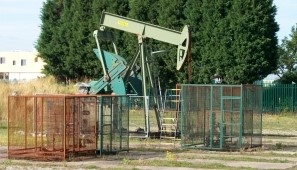
A Nodding Donkey
CHURCHES
25. What year was St Stephen’s Methodist Church built?
Answer: 1964
Saint Stephen’s Chapel was built on the site of Wesley Chapel, North Street, in 1964 and opened in 1968. In 1999, following the closure of the Centenary and Whiteswood chapels, the name of Saint Stephen’s was changed to ‘Gainsborough Methodist Church’.
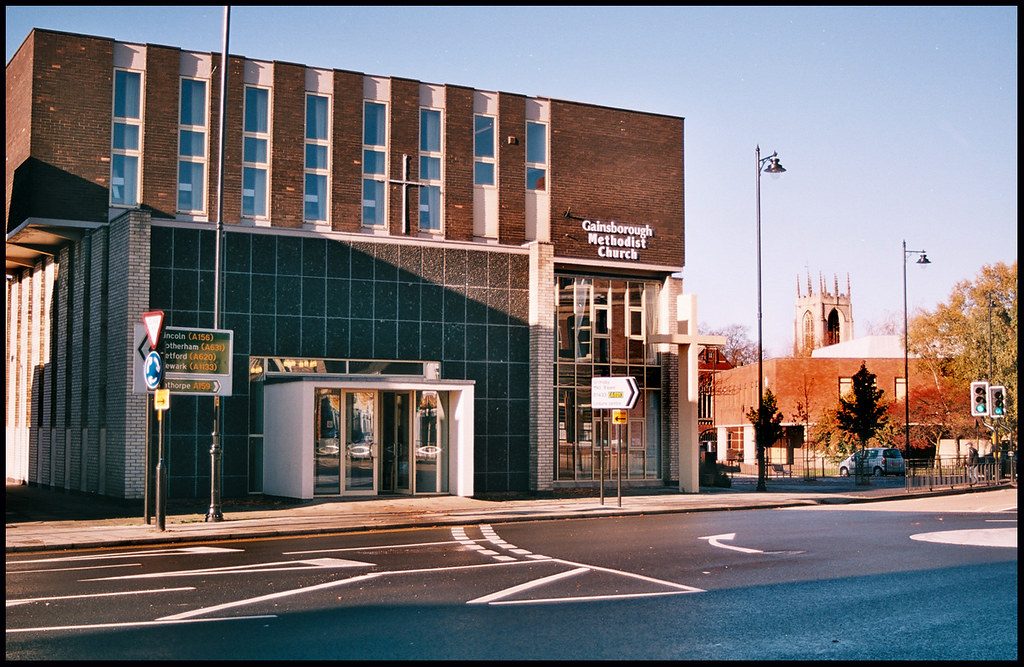
Gainsborough Methodist Church
26. When was the current St Paul’s Morton opened?
Answer: 1891
St Paul’s Church is a Grade 2 listed building, completed and opened in 1891. In the 1840s, the vicar of Gainsborough wrote of a “most oppressive weight of responsibility” in having Morton and East Stockwith in his parish. To relieve himself of that responsibility, he opened a subscription list towards the building of churches within those two districts. A site for a church at Morton was given by Sir Henry Bacon Hickman Esq. Lord of the manor of Gainsborough and building commenced on 1 May 1845. On 3 July 1846 the church of St Paul was consecrated.
St Paul’s Church
On 19 December 1846, the church was assigned a particular district and henceforth legally, Morton became an ecclesiastical parish; and from 1 January 1847, kept its own registers.
In 1890, a public meeting was held and it was decided to enlarge the church. Due to the munificence of Sir Hickman Bacon, premier Baronet of England (and the local squire), the present day magnificent church was completed in 1891.
Designed by Messrs. J. T. Micklethwaite & Somers Clarke of Westminster, it has a nave, a chancel and a side chapel dedicated to St Hugh of Lincoln. Described as one of the loveliest churches in Lincolnshire, a gem of a Victorian church, it boasts a font of Frosterley marble, in which can be seen fossilised shells surmounted by a beautifully carved wooden canopy lifted by pulleys. The organ is by Augustus Gern, built in 1891 to his invention of a tubular action for organ building. The organ case is a wonderful piece of craftsmanship, gilded and painted in green and red; it is mentioned in “The British Organ” by Clutton & Nillard.
The church is home to one of the finest collections of stained glass windows designed by the great Victorian artist Sir Edward Burne-Jones R.A. who worked on them in co-operation with the famous Victorian designer William Morris. In the chancel there is a William Morris carpet.
27. Listen to the audio clip below of Rosemary Speck talking about nearby Church bells to where she grew up in the south of the town, can you identify which Church this might be?
Answer: St John The Divine
St John The Divine Church
Building of St John’s Church started in 1881-2 to accommodate the rapidly growing population of Gainsborough. The original plans were for a 6-bay aisled and clerestoried nave, 2-bay aisled chancel and a W tower, and the blind, unfinished aisles in the chancel and the eastern part of the nave reflect this ambition. However, only the body of the chancel and eastern four bays of the nave were built in 1881-2; the western part of the nave, including the partial aisles, was added in 1901-4. The architects for both phases were the highly regarded church architects J T Micklethwaite (1843-1906) and Somers Clarke (1841-1926). The church became redundant in 2002 and was converted to an arts and performance space in 2004. For more information on this Church check out the British Listed Buildings page.
28. What years did the Holy Trinity Church convert into the Trinity Arts Centre?
Answer: 1982 – 84
The Former Holy Trinity Church now the Trinity Arts Centre
The church was built in 1841-43 to accommodate the growing population of Gainsborough. Its cruciform plan, with a tiny chancel, large, three bay transepts and an unaisled nave with a W gallery was designed for pre-Tractarian, prayer book worship, with pews facing inwards from three sides. The architect, Thomas Johnson of Lichfield (1794-1865) built a number of churches in the Midlands. It was repaired and the chancel enlarged in 1871, and further work was completed in 1911. It became redundant in 1973 and was converted into an arts centre in 1982-84.
PICTURES
29. The picture below shows a building that was demolished in 2013, do you remember whereabouts in the town that this building stood and what was the building used for?
Answer: Guildhall
The picture shows the former headquarters of the Gainsborough Urban District, and later the West Lindsey Councils – the Guildhall.
Guildhall
The Guildhall was built for the former Gainsborough Urban District Council, and opened on the 7 July 1966 by Sir Roger Stevens, Chairman of the Yorkshire & Humberside Economic Planning Council. It was built directly behind the Georgian Terrace on Lord Street that had been the Council’s offices up to that point. Immediately after construction of the Guildhall was complete, the Georgian buildings were unfortunately demolished to allow the side entrance (on Lord Street) to be accessed. The new building was a concrete framed structure clad externally on the principal elevations with Portland stone and Westmorland slate. Hand-made facing bricks were used on the other elevations.
The main entrance on Caskgate Street (though within five years of the Guildhall’s construction the route of Caskgate Street was moved about 30 yards to the West) was supported by columns – supposedly in homage to Pillared House, a well known town landmark that had been demolished in the 1930s. Along the roofline of the Guildhall was a concrete wave – a reference to the Aegir (Tidal Bore) on the River Trent which the Guildhall overlooked.
With the reorganisation of local Government in 1973-74, the Guildhall became the main headquarters of West Lindsey District Council, which occupied the building (and extended it) until it moved to new premises in Marshall’s Yard in 2008. The Guildhall stood empty for many years until finally being demolished.
30. The picture below shows KFC in Gainsborough, do you remember the building that once stood in this location?
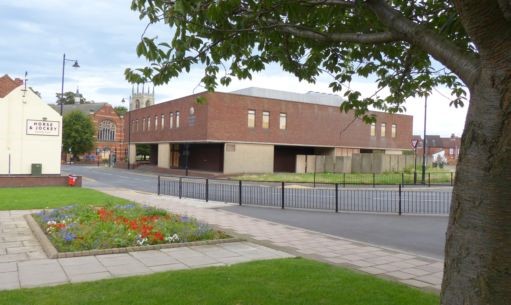
Answer: Magistrates Court
The Magistrates court was built on Roseway in 1975. However, it was demolised and Kentucky Fried Chicken (KFC) was built in its place.
31. The pictures below show two buildings that have been demolished in the town, do you remember what the buildings were used for and when they were demolished?
Answer: Castle Hills Secondary School, demolished in 2010
Castle Hills Secondary School
The school was opened in 1958 as the Castle Hills Secondary School, Gainsborough (during the planning stage it had been known as The Avenue Secondary School, Gainsborough). It was known as The Castle Hills Community School by 1997 and the school was demolished in 2010.
Answer: Middlefield Lane Secondary Modern School, demolished in 2010
Middlefield Lane Secondary Modern School
Middlefield Lane Secondary Modern School opened in 1966 and was amalgamated with the Castle Hills School to become the Trent Valley Academy. The former school was also demolished in 2010.
PLACES
32. What year was the Trent Bridge freed from tolls?
Answer: 1932
The bridge was built by the civil engineer, William Weston between 1787 and 1791. It is a handsome and substantial three span bridge in ashlar masonry. The overall width was 26 ft 3 in, although cantilevered walkways have been added subsequently.
The bridge is Weston’s only known work in Britain as he left in 1792 from Falmouth for the United States of America for the Schuylkill and Susquehanna Navigation Company as canal engineer and superintendent. When completed it was the only bridge across the River Trent above Newark-on-Trent.
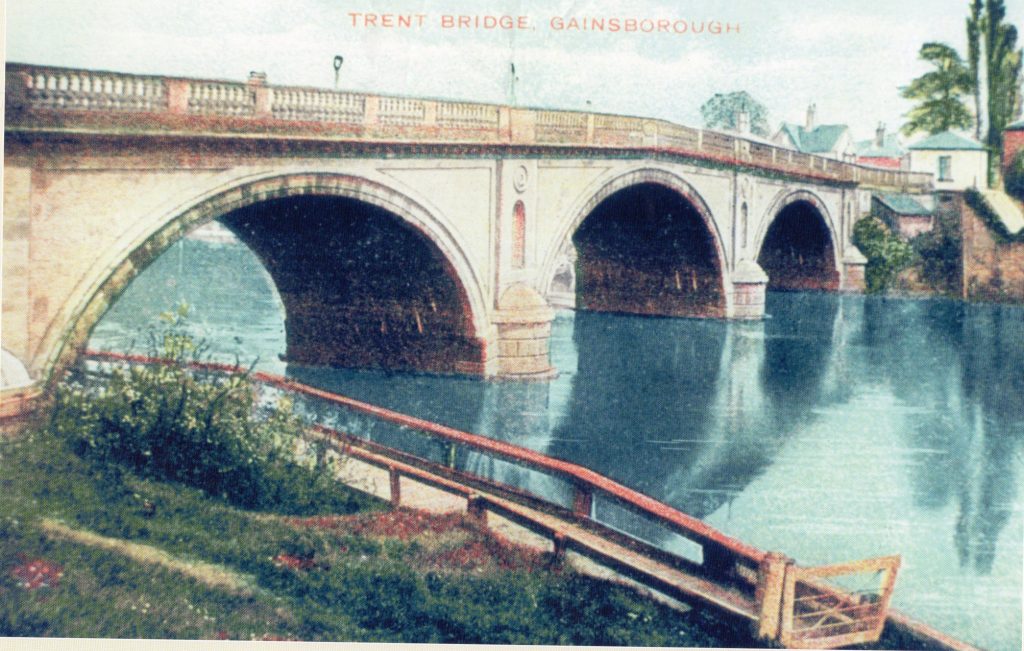
Gainsborough Trent Bridge
In 1932 a white metal medallion was issued to celebrate the freeing of the toll bridge. The toll bridge was purchased on 31 October 1927 for £130,000 and freed from toll on 31 March 1932.
33. When was the Trent Bridge widened to accommodate more traffic?
Answer: 1964
The Gainsborough Bridge was widened in 1964
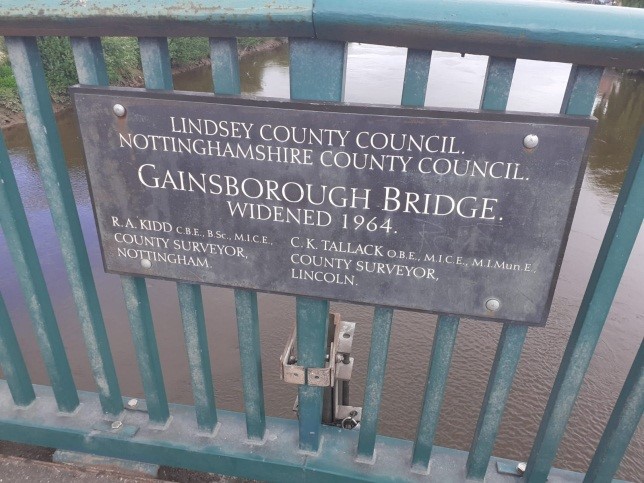
Gainsborough Trent Bridge Widening
34. When was the Gainsborough Library opened?
Answer: 1905
The decision to set up a free library in Gainsborough was made in 1891 but it was not until 1902 that Councillor Joseph Barlow, Chairman of the Urban District Council, wishing to commemorate the accession of Edward VII, asked the Scottish American philanthropist, Andrew Carnegie, for financial help. Sir Hickman Bacon gave a site in the Mart Yard on the condition that the design of the new library harmonised with the 15th century Old Hall opposite. The library was designed by Scorer and Gamble who were in partnership in Lincoln from 1901 to 1913.
- Gainsborough Carnegie Library
The library opened in 1905 and is a good example of a surviving Edwardian public library. It was administered by the Urban District Council and originally held 1800 books in the lending library and 80 on reference. It is of red brick laid in English bond with ashlar stone dressings and a roof covering of slates laid in diminishing courses. It faces north onto the road opposite Gainsborough Old Hall with which it is in architectural harmony. The library building is in a decorative late Tudor style with expansive mullioned and transomed windows. The central bay projects to form a classical stone porch which has a moulded architrave with ‘PUBLIC LIBRARY’ engraved on the frieze. The keystone above the door is carved with the date 1905. The well-crafted interior, embellished with delicate plasterwork and classical motifs, is characterised by a lofty elegance reminiscent of the 18th century.
The entrance door opens into a small stone-clad porch that leads to the main double-leaf door. Above the interior doorway is a metal scroll-shaped tablet inscribed with ‘THIS LIBRARY WAS ERECTED IN THE YEAR 1905 BY THE MUNIFICENCE OF ANDREW CARNEGIE’. It is the oldest purpose-built library still used as such in Lincolnshire. The rear range has an inserted mezzanine accessed via a straight flight of stairs, probably added in the last quarter of the 20th century. The private rooms in the library also retain some original joinery and fittings. The original wall tiles in the lavatory survive but have been painted over. Some of the interior doors have been replaced by fire doors. On the east side of the library is a pair of red brick square gate piers with a wide stone band and flat moulded caps.
35. What Gainsborough supermarket is currently based in the area where the Union Workhouse once stood?
Answer: Aldi
A poorhouse was first built in Gainsborough in 1730. It was built around a square, closed off from Church Street by a high wall. After 1834 the Gainsborough Poor Union was officially formed on 19 January 1837. Its operation was overseen by an elected Board of Guardians. A new Gainsborough Union workhouse was built in 1837 on Lea Road at the south-east of Gainsborough.
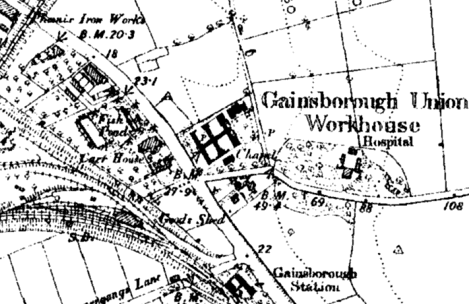
Gainsborough Workhouse Site 1887
The Poor Law commissioners authorised an expenditure of £3,500 for construction of the building which intended to accommodate 200 inmates. It was designed by George Wilkinson who was the architect of many other workhouse buildings, although Gainsborough was the only one in Lincolnshire. His design was based on the model “square” plan published by Commissioners in 1835. The Chapel, at the south of the workhouse, was erected in 1861 at a cost of £800. It contained a stained-glass window in memory of Thomas Oldham, Clerk to the Guardians from 1837 to 1861.
After 1930, the workhouse became a Public Assistance Institution and later a residential home under the name of Oakdene. The former workhouse buildings have now been demolished. The supermarket of Aldi now stands in its place. For more information on the Gainsborough Workhouse click here…
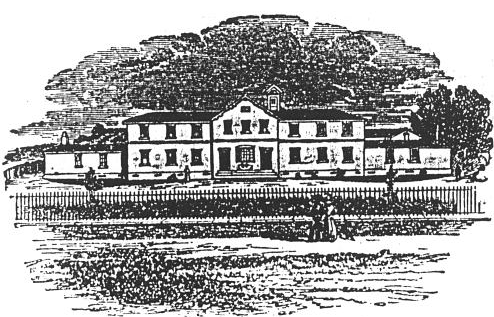
Gainsborough Workhouse 1843
36. When was the Water Tower on Heapham Road built?
Answer: 1897
Built in 1897, the tower is a grade-II listed building and is surrounded by a former reservoir which was constructed in 1864. The paragraph below is taken from British Listed Buildings, for more info click here…
Engineer Henry Riley. Red brick with yellow
brick panels, some sandstone dressings, iron-framed windows, and
lead roof. Hexagonal plan. Built against a reservoir embankment,
with 4 storeys plus a semi-basement storey accessible through a
doorway on the east side. 4 of the sides have narrow round-arched
windows to their ground and 1st floors, set within yellow brick
panels and with arches of rubbed red bricks. The rear side is
similar but has a ground-floor doorway with shouldered lintel.
The front side, facing north-east, has a round window at 1st
floor level. At ground-floor level there is a marble plaque with
pedimented sandstone surround. Its inscription records that
construction of the tower and reservoir was commenced by the
Urban District Council of Gainsborough in 1897 and lists the
names of members of the council, the clerk, engineer, and
contractor. The 3rd and 4th storeys are separated by a sandstone
cornice with Lombard frieze. Below the frieze on the front side
the 3rd storey, which is otherwise blank, has 2 round-arched
windows with a sandstone surround, transom, and brick apron. The
upper storey has 2 round-arched windows to each side, separated
by sandstone pilasters. The 6-sided lead roof has a Crowsnest
with iron railings and a flagpole.
- Gainsborough Water Tower
Thank you for taking part in Gainsborough’s History Quiz.

